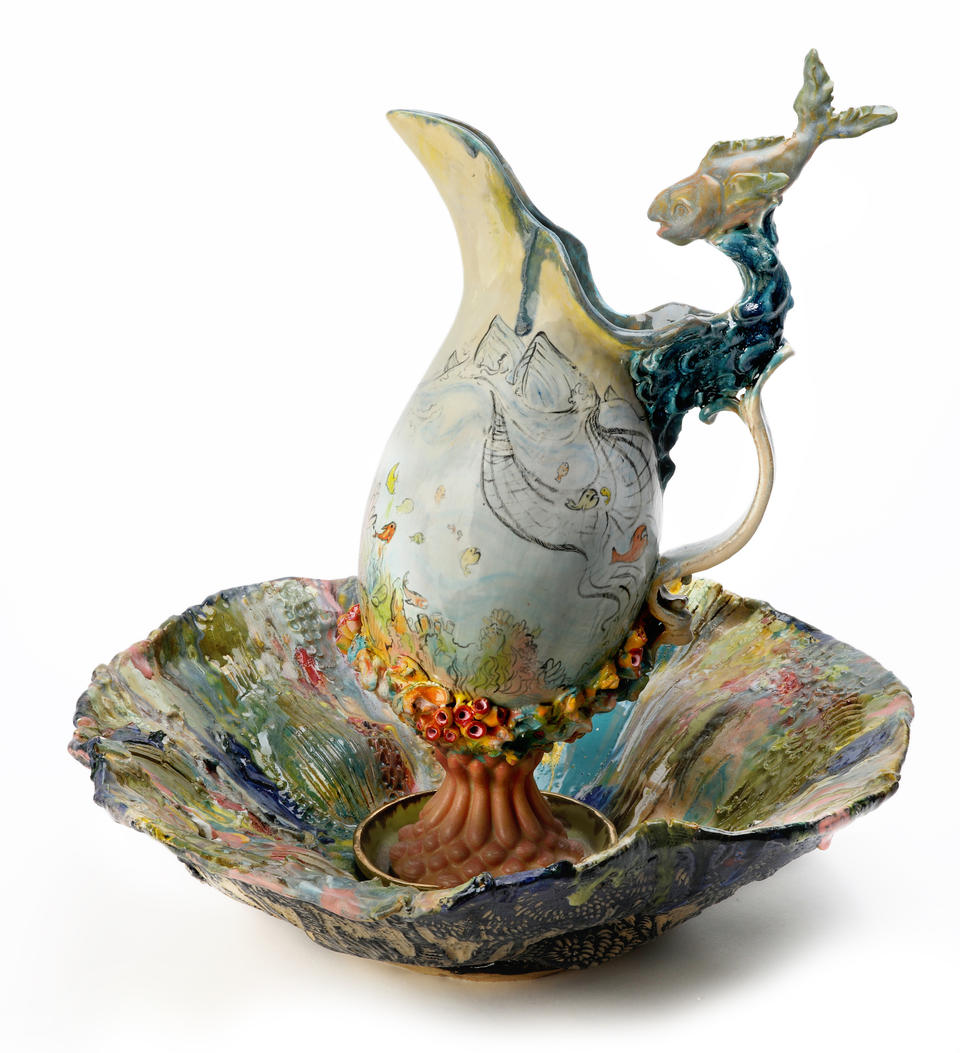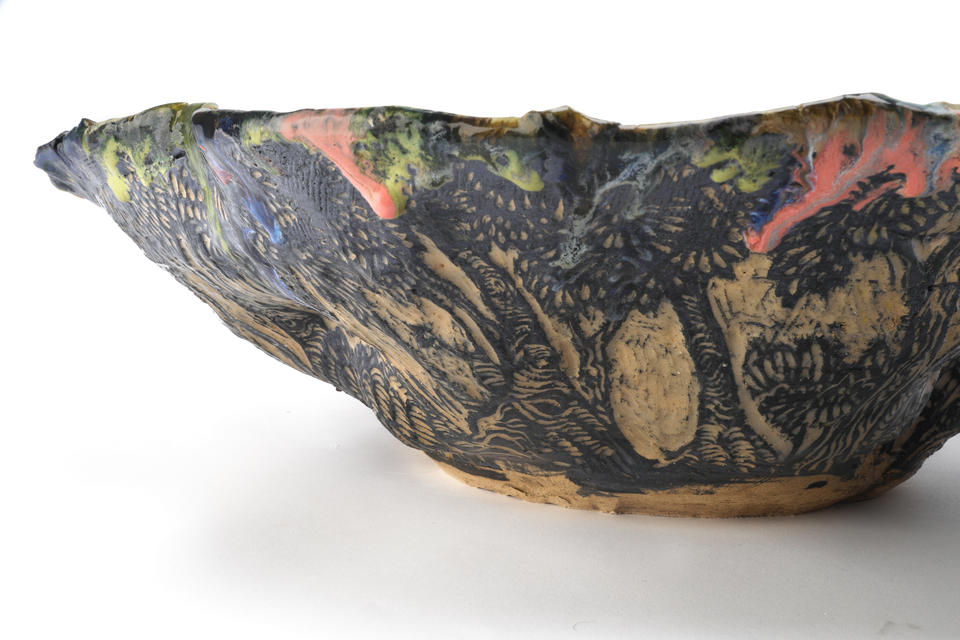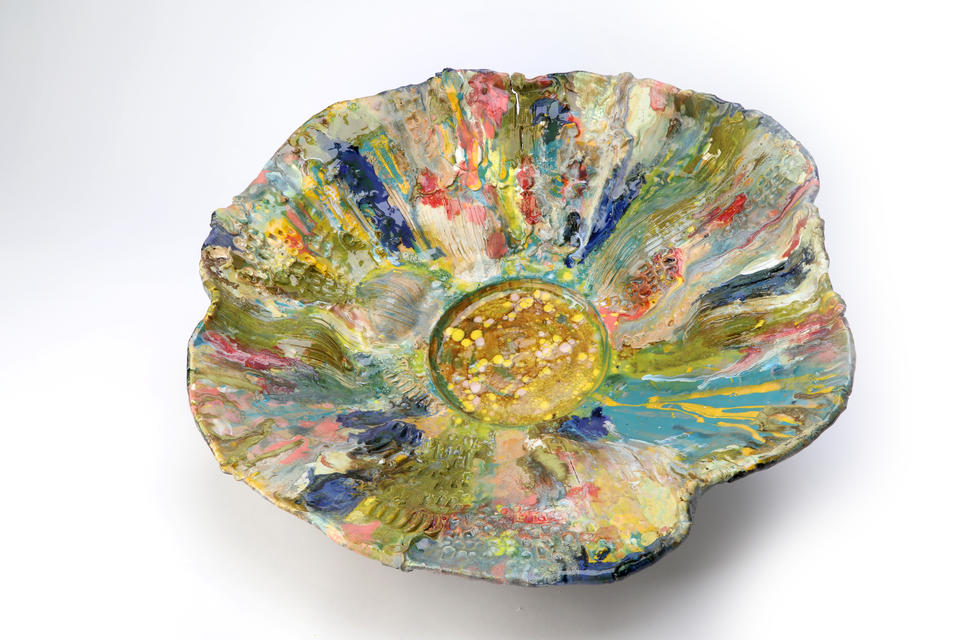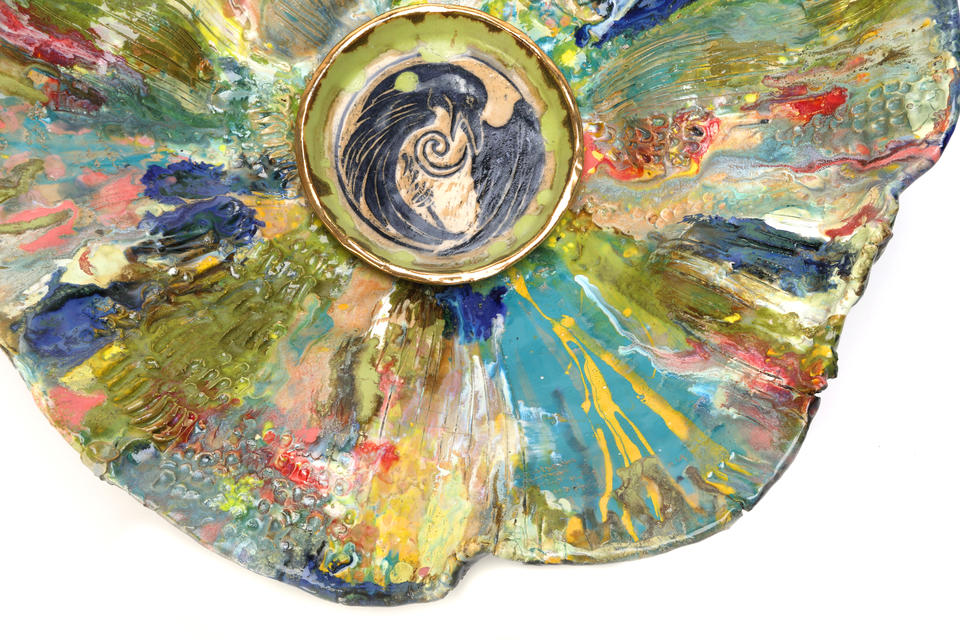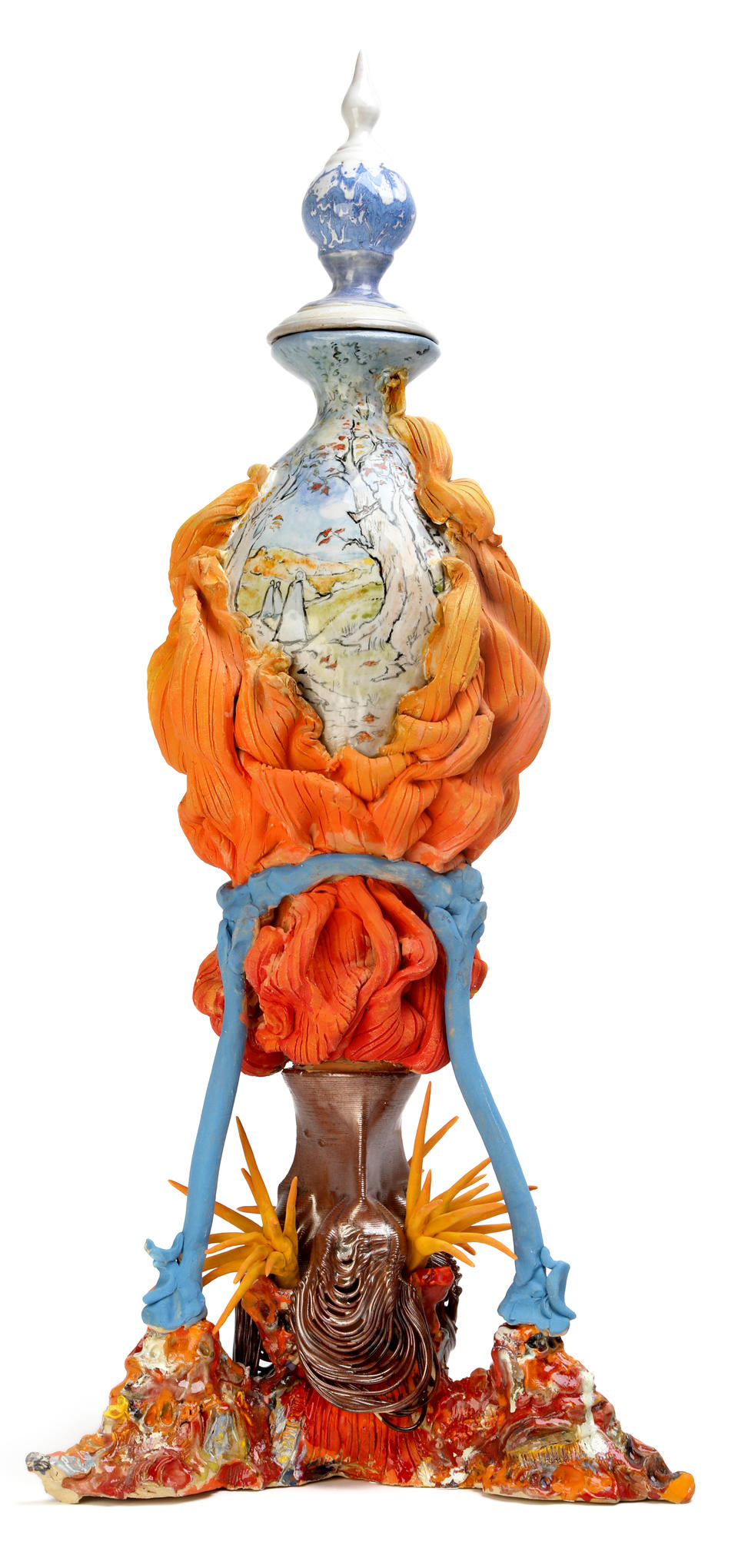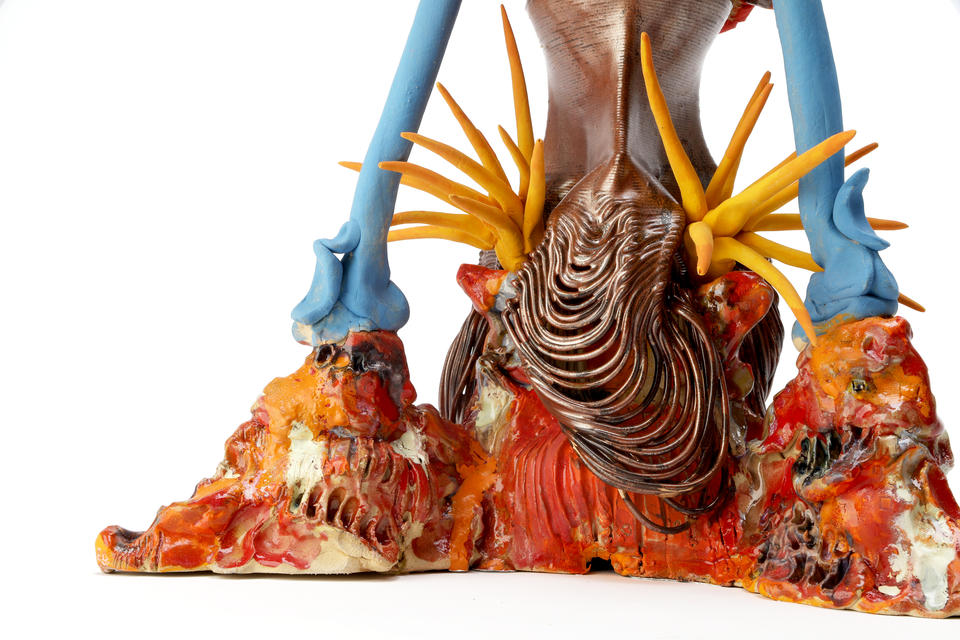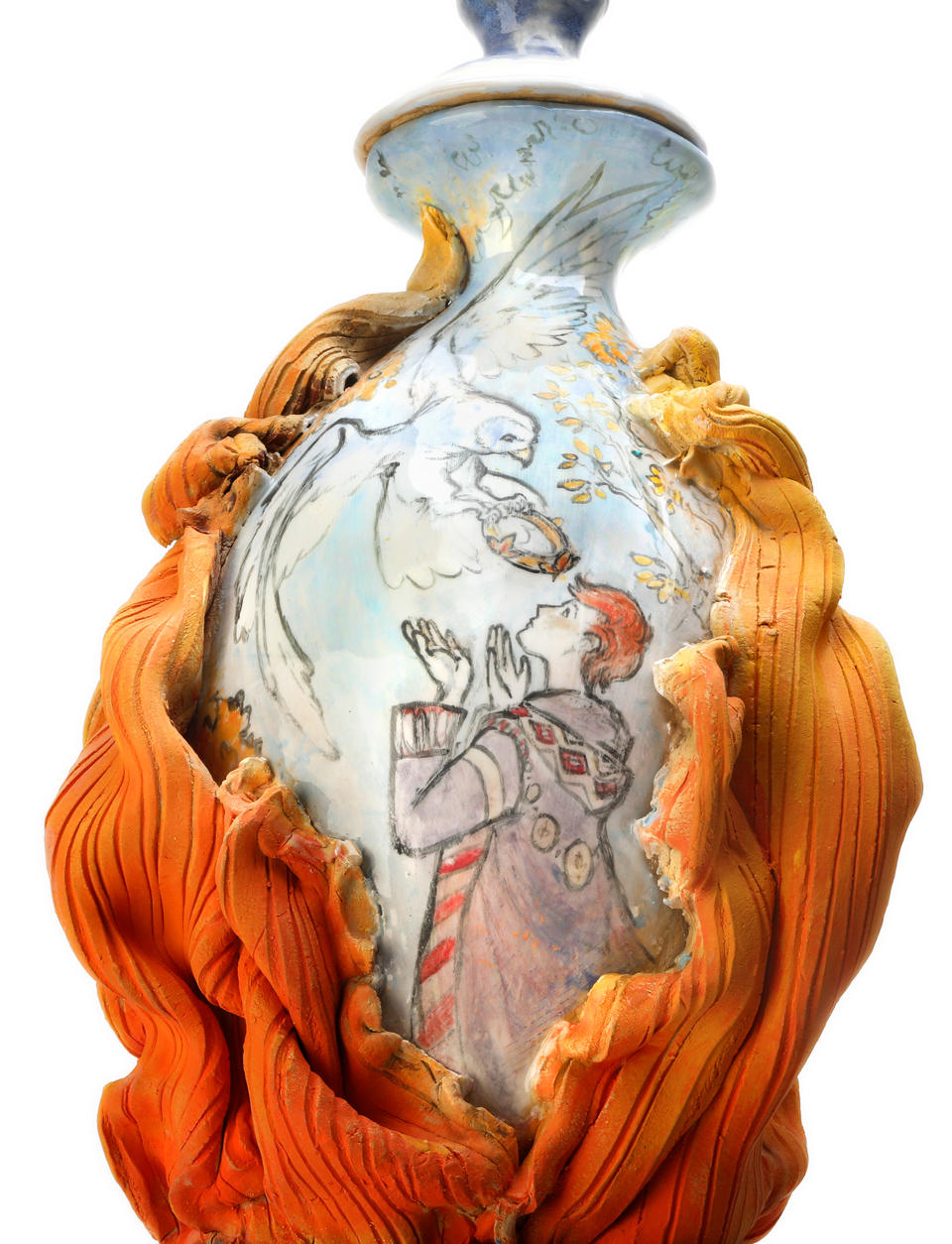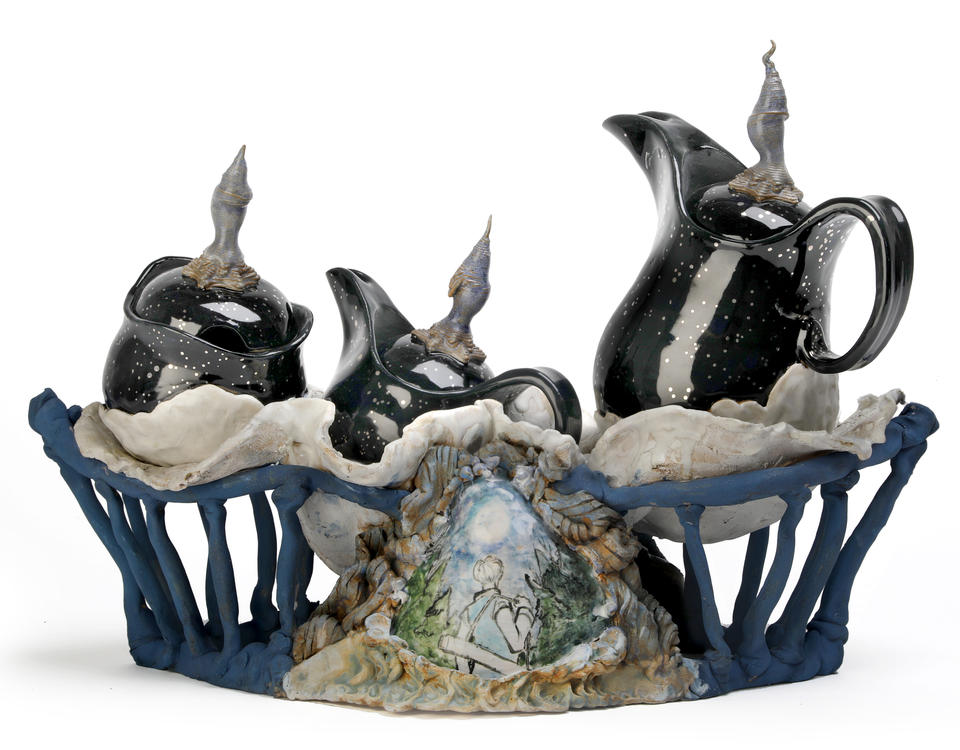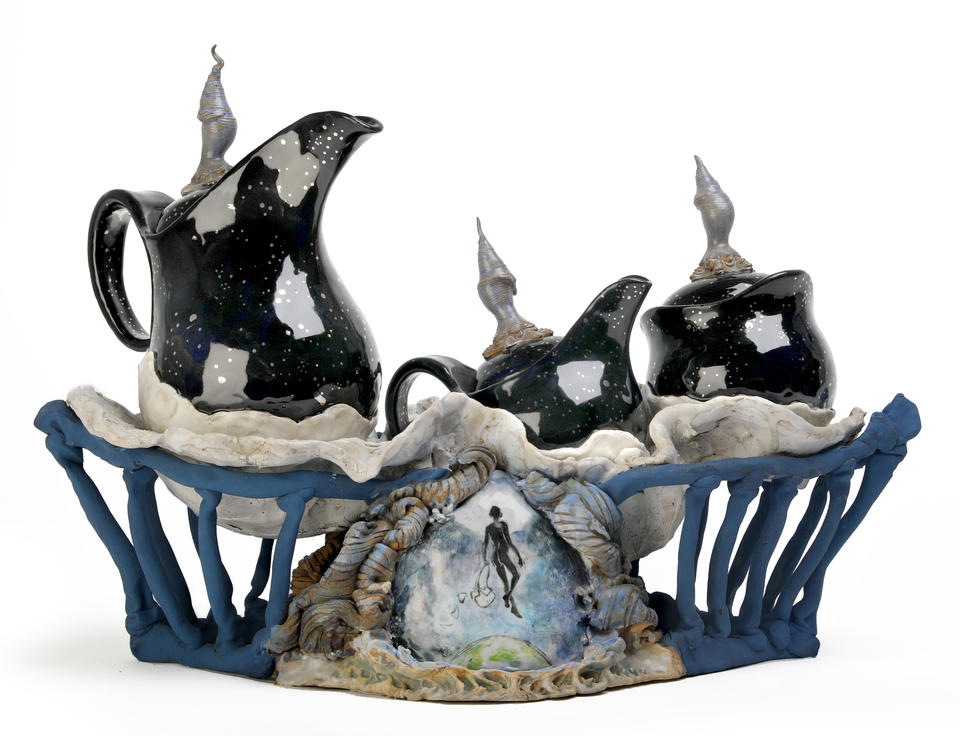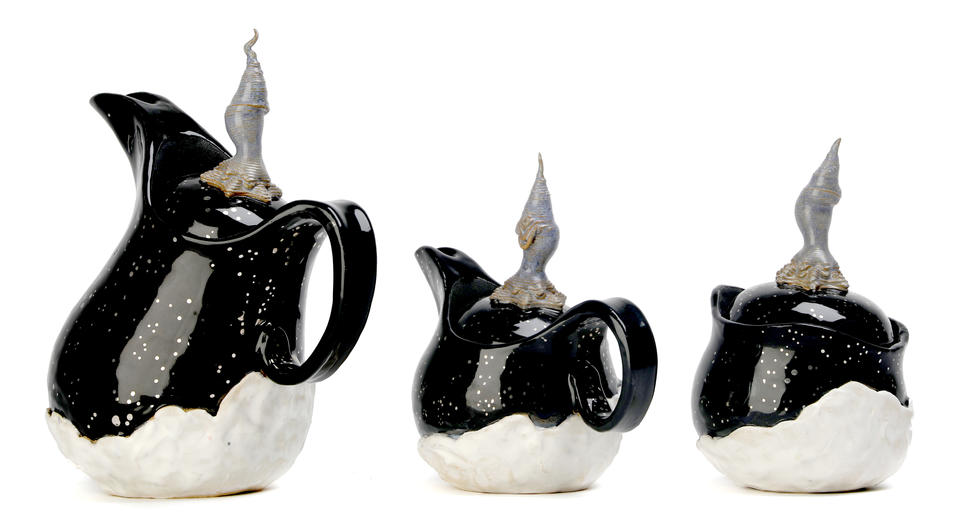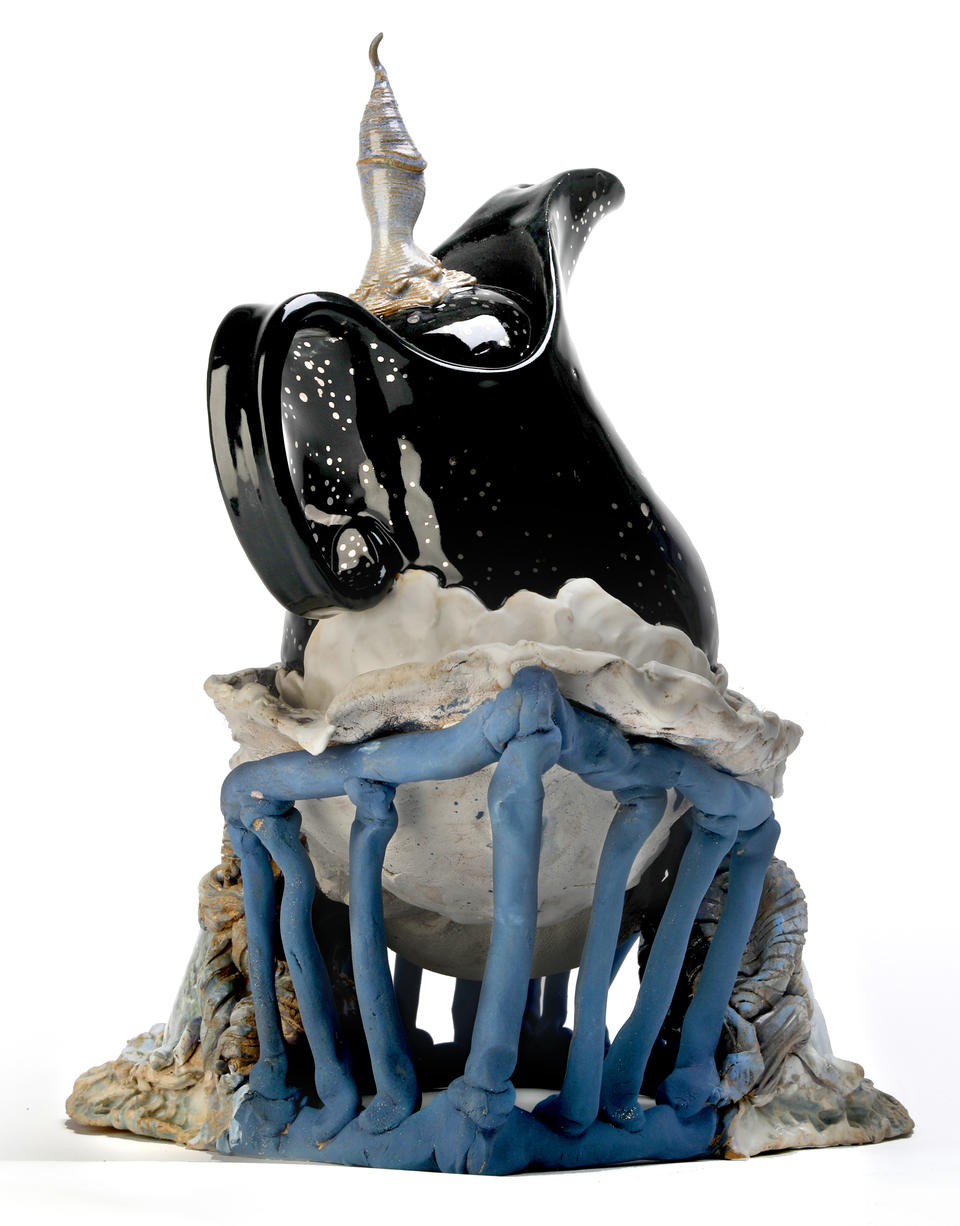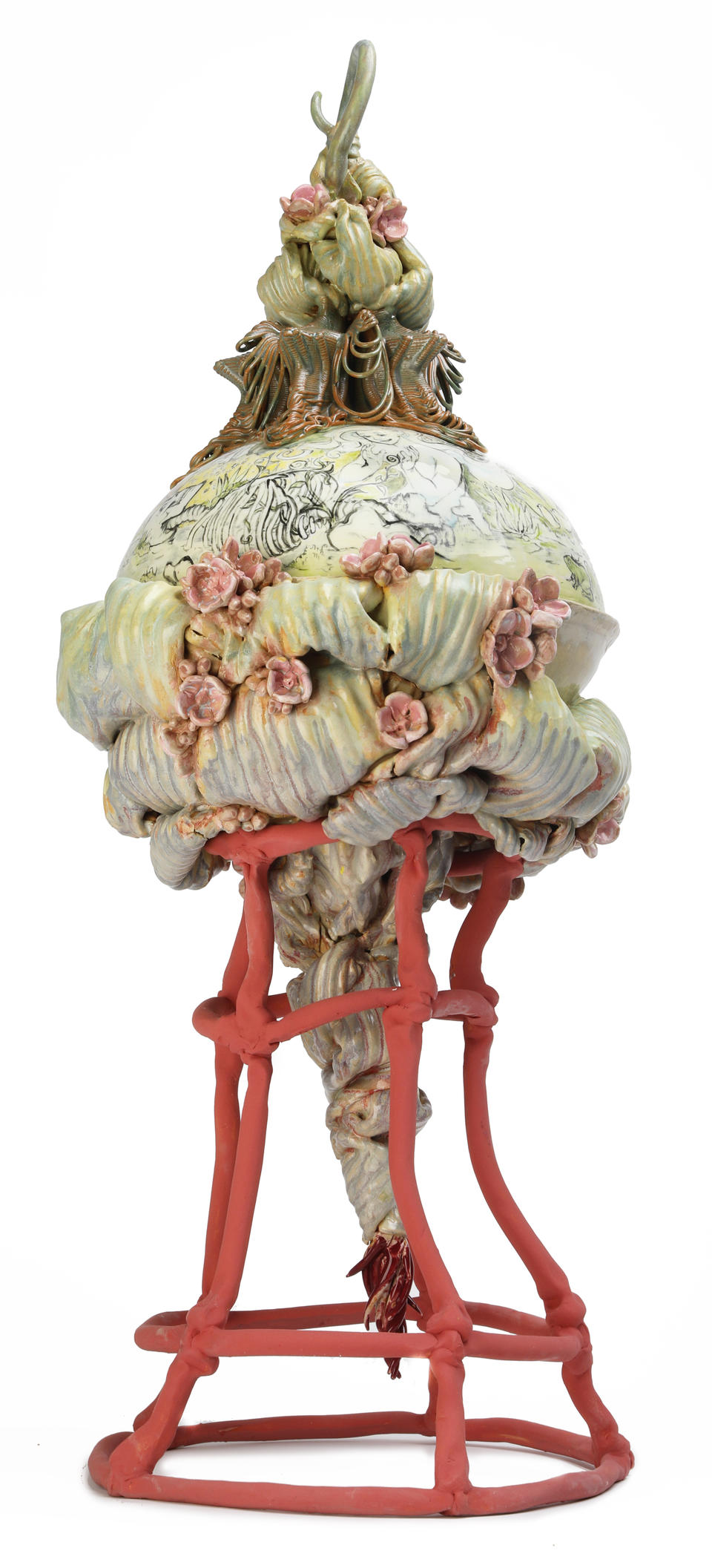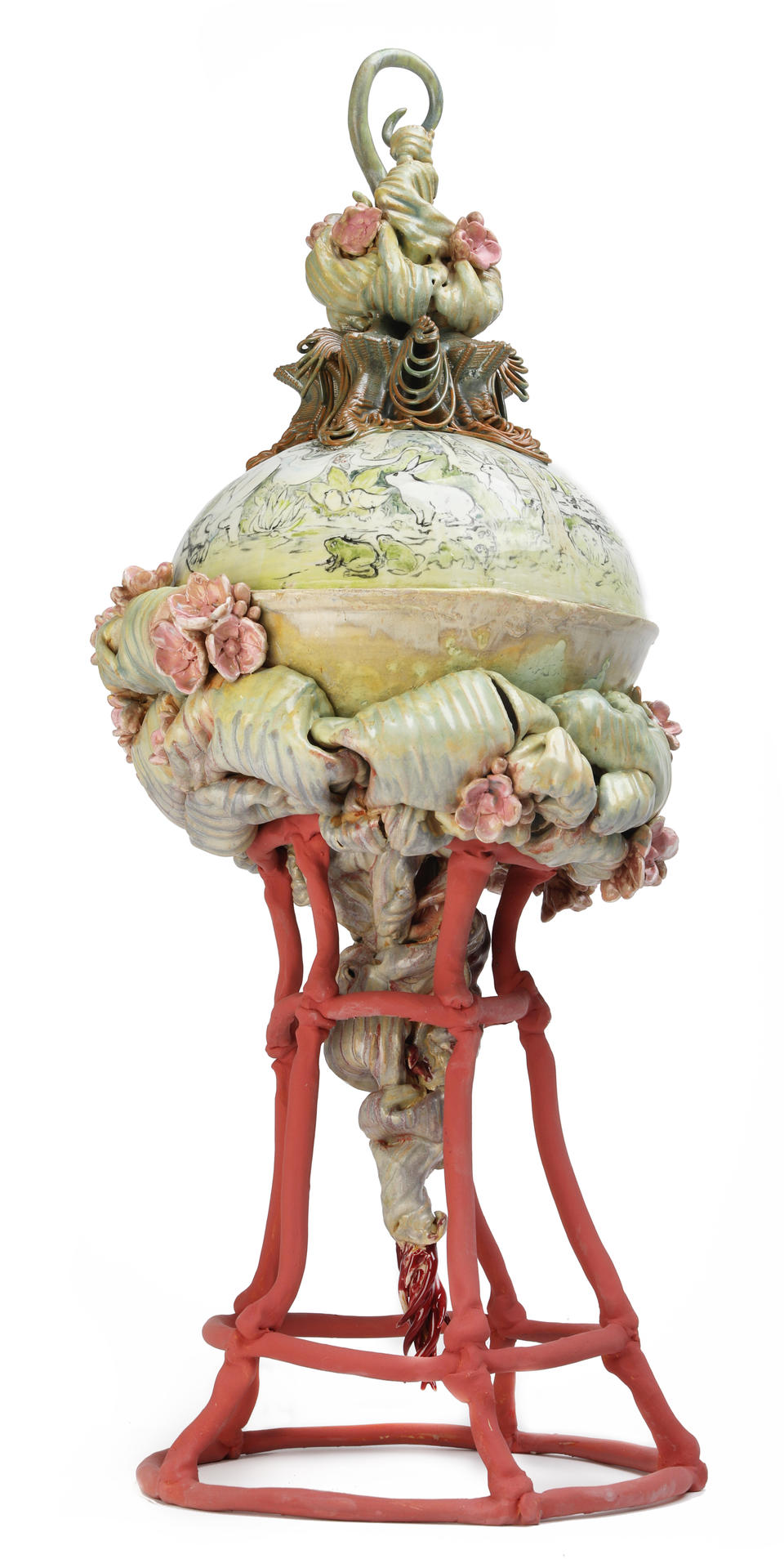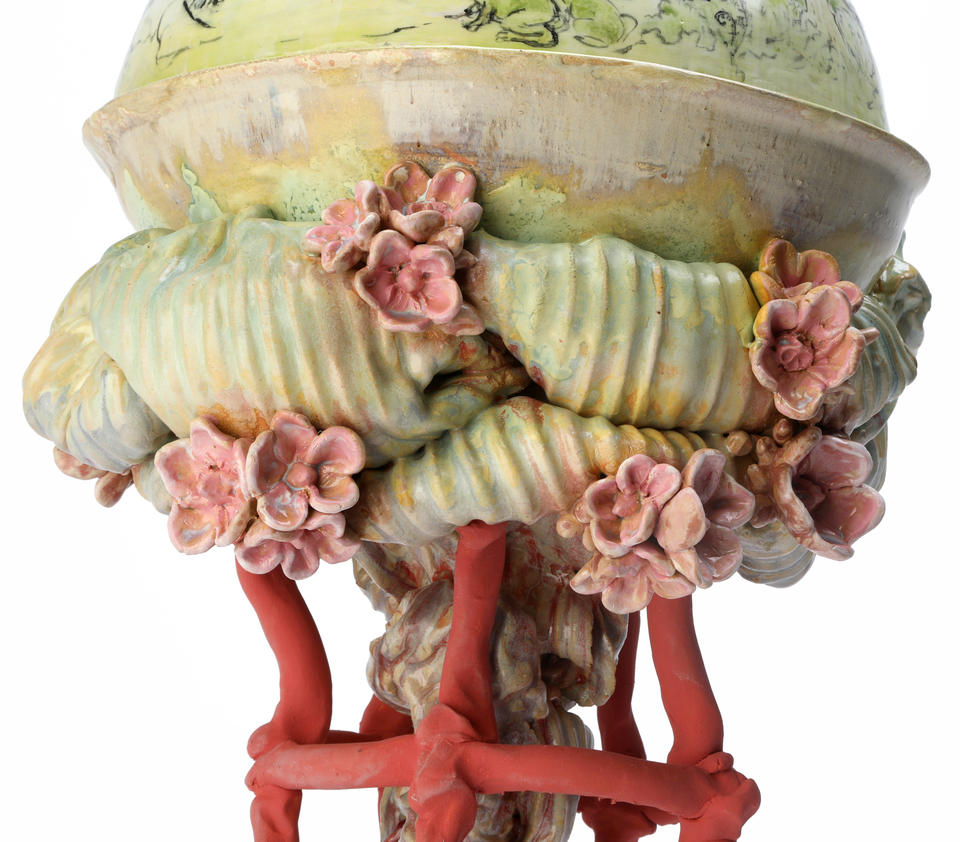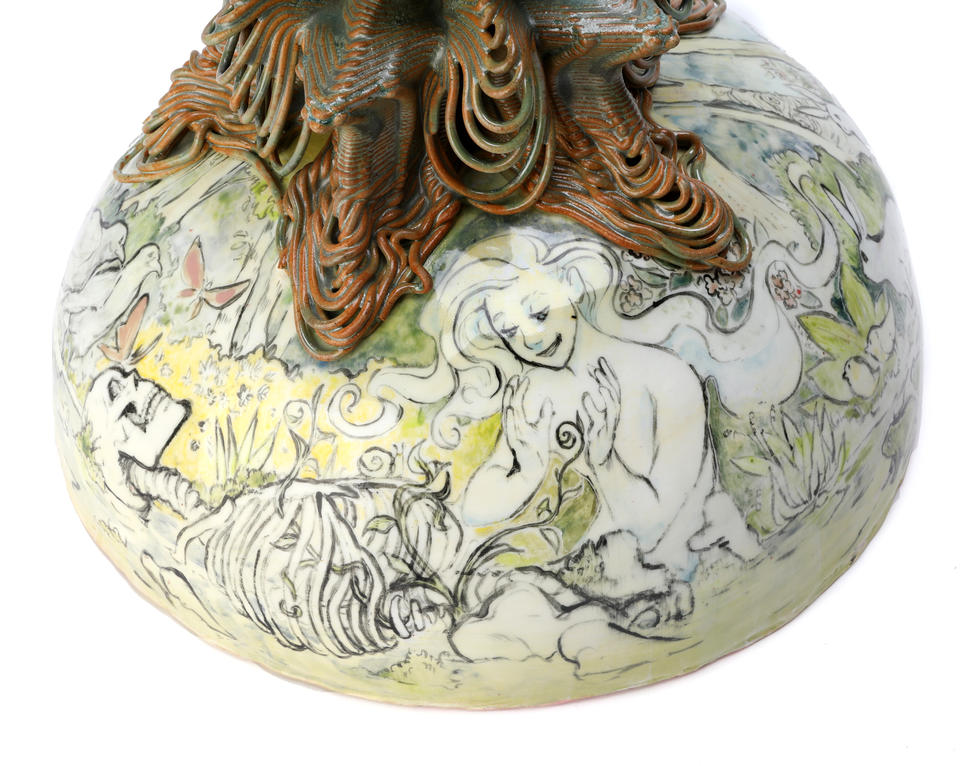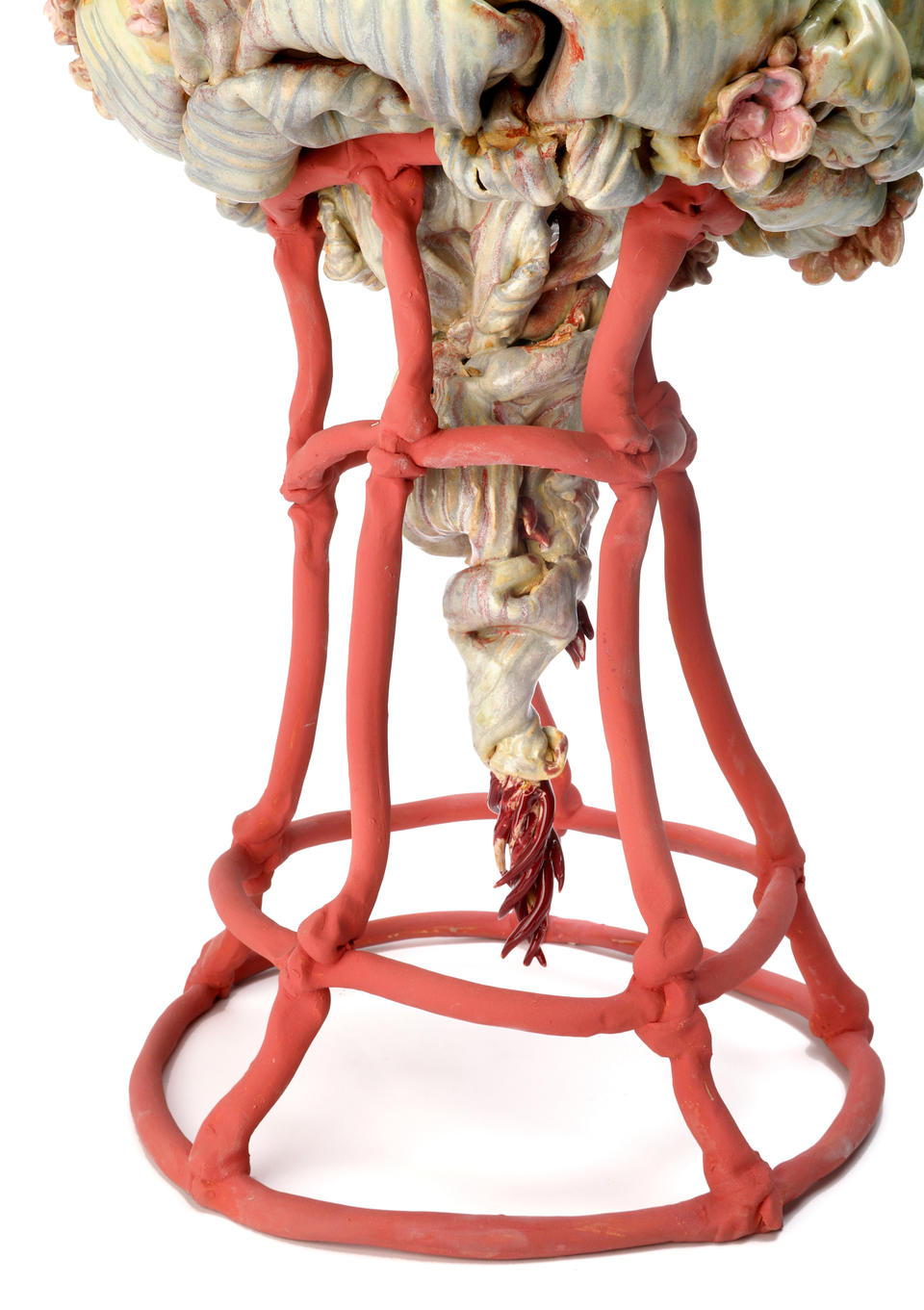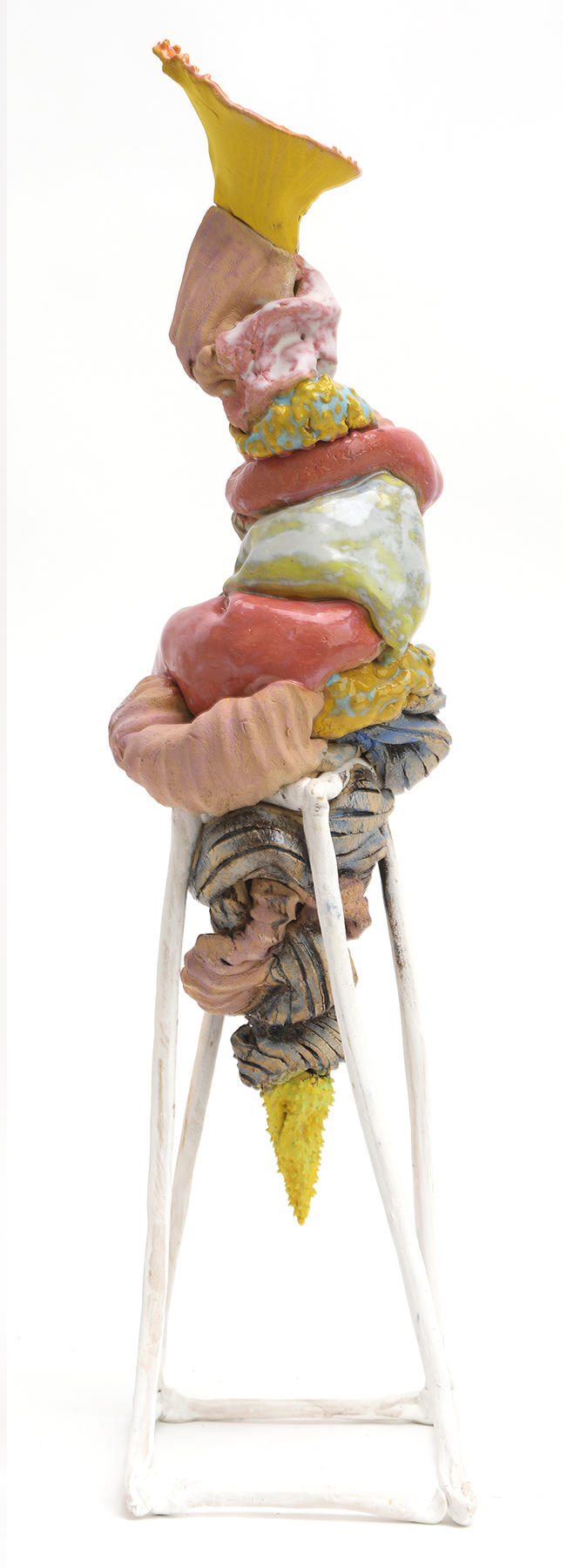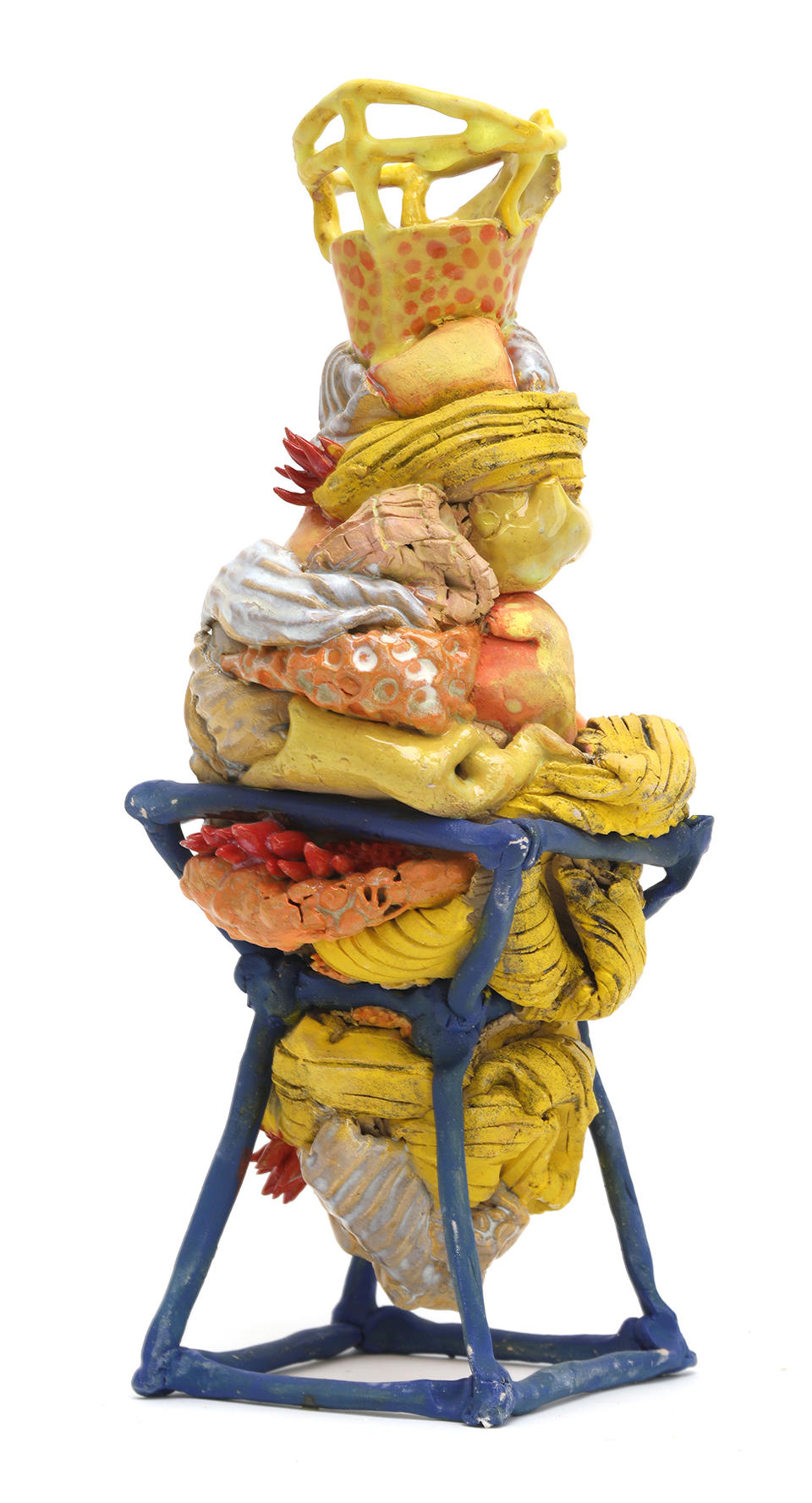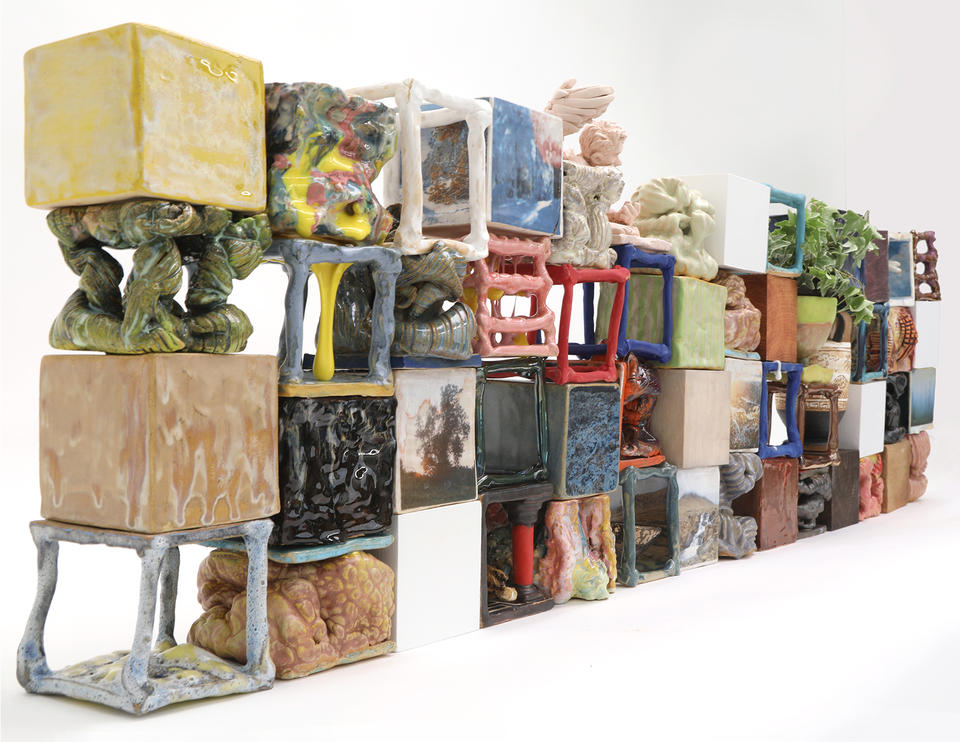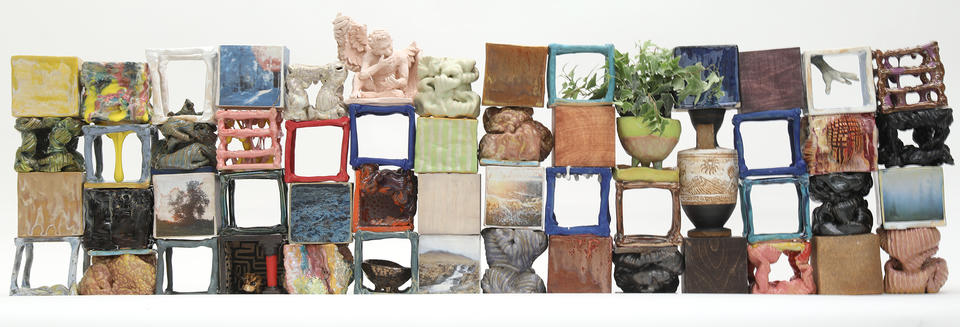ABSTRACT
In biology, a chimaera is created when two zygotes collide at an early stage of development, resulting in a unique creature containing two distinct sets of genes. The name is borrowed from Greek mythology where chimaeras are fire-breathing monsters born with the mixed attributes of lions, snakes, and goats. As creatures of myth, chimaera represent a narrative union of disparate parts; a collision of the fantastic and the mundane.
Clay can be used to explore this dichotomy, utilizing its ability as a mutable canvas to embody a vast range of visual vocabularies while referencing its rich history and placing new creations into context.
The Fableware of the Garden of the Grotesque features ceramic vessels that tell the stories of metamorphosis and hybridity within an otherworld. Through the lens of the chimaera and the medium of clay the lines between story and vessel can begin to blur and guide viewers to ask what is possible rather than what is “natural.”
Each fragment constructing a chimaera has its own history, and these origins are expressed in their temperament, compositions, and collision with other pieces. By using the chimaera as a model of synthesis, we can center the possibility of what could happen in life rather than become stuck in the expectations of what should happen. By using the chimaera as a blueprint we can find empathy for ourselves and others as beings composed of many influences and experiences. A fusion of the fantastic and the mundane.
Image
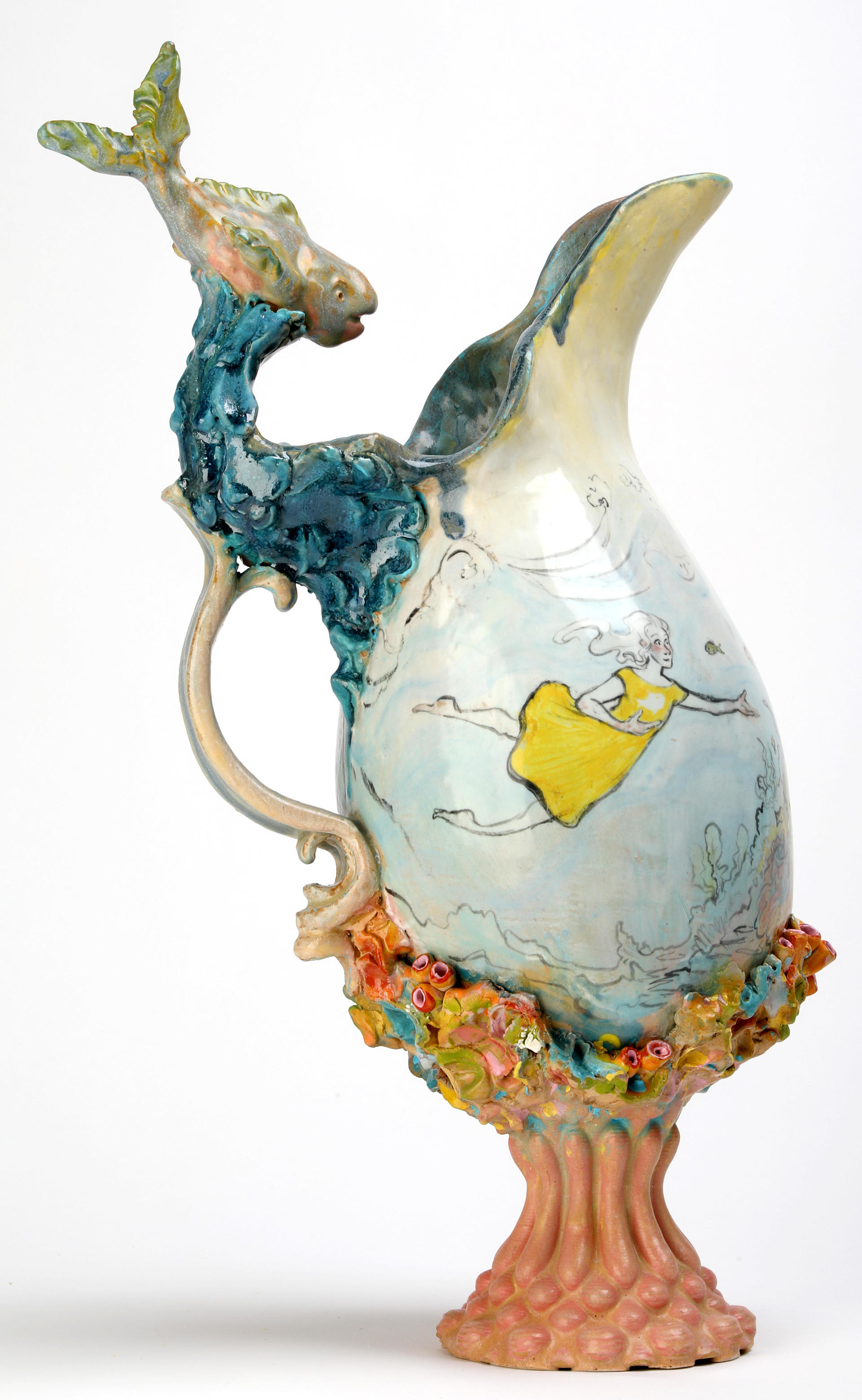
"Summer." 2021. Work is approximately 30"T x 12"W x 8"D
The Fableware
featuring excerpts from The Fables themselves
Excerpts from
Summer
-------------------------------------
There is a grove in the Garden of the Grotesque that is never empty, always gathering creatures and stories beneath its laden branches.
One afternoon, a storm finds itself lodged overhead; it apologizes to the grove with humble rumblings. A raven finds itself caught under the boughs, soggy and tired, wanting to pause for a moment to get out of the rain.
“Why have you stopped here?” The grove asks the raven. “I am already full enough of creatures, I do not know if there is room for you to stay.”
“I only need a moment out of the rain.” The raven responds.
The grove ponders for a moment.
“You may stay if you tell us a story," The grove answers, "since there is always room for more of those.”
-------------------------------------
There once was a girl who walked along a beach to the same party every day. On the cusp of childhood, the girl had not yet acquired worries, for the weather was always fair and the walks always pleasant.
The journey was long enough that she occupied herself by looking out at the sea, dreaming of what might happen beneath its mysterious blue veil.
One day the girl heard a small voice that came from a tidepool just off the path. When she stooped down to look inside she found a beautiful glittering fish.
“You must help me!” The glittering fish said. “There was a great storm this morning and the world spun and twisted and dragged me far away from my home! I cannot make it back to the ocean with the tide so far away!”
"Summer" (2021). Pitcher is approx. 30" T x 8" W x 6"D. Basin is approx. 6"T x 22" W x 22"D.
Excerpts from
Autumn
-------------------------------------
The Garden of the Grotesque once had a luxurious, glorious summer that ended in the death of a king. News of his death carried on the wind, crisp and brisk, from one corner of the garden to the other. Even the leaves began to droop in respect, growing inflamed with their best mourning colors to celebrate the end of a great king.
The king’s one and only son pushed aside his advisor’s advice to prepare for the changing seasons and called for a week of festivities leading up to a lavish banquet where he was to be crowned. Invitations were sent to the entirety of the garden and all were asked to attend, regardless of their harvests.
-------------------------------------
It wasn’t until mid-evening that silence blew across the crowd: the prince had arrived.
The prince glanced about the room until his eyes found the glint of the golden wreath in the grasp of the owl sage. As the prince started forward, passing crowds looked for a trace of the Summer King in this Autumn Prince. the prince’s eyes fixed on its sparkle and the resemblance to his father grew less and less.
As the owl sage placed the golden wreath upon the prince’s head, the once sweet breeze acquired a bitter taste. The Autumn Prince rose, now an Autumn King, who turned to finally speak to the waiting throng.
“Soon will be the end of shorter days and colder nights! Winter will not hold us in its sway! Let us feast, for summer will be on its way once more!”
It was not until the next morning that the Autumn King woke to find small roots anchoring him to the ground.
In a morning haze, the advisors were called and yanked him from the ground. The advisors called doctors who confirmed that the roots grew from his body. The doctors called gardeners who were threatened with execution after a pruning attempt gone awry. It was the arborists who finally identified the roots and determined the king was becoming a tree: if the king stopped moving for too long, he would root to the ground.
"Fall" (2021). Vessel is approx. 42" T x 12" W x 12" D.
Excerpts from
Winter
-------------------------------------
There once was a man who took the job of a mapmaker so he could walk the endlessly shifting roads of the Garden of the Grotesque and spend his nights dreaming of the stars.
Once a task of new exploration, updating the maps day by day and year after year had become a frustrating job filled with seeking out roads that never seemed to be where you last saw them. While he worked a part of his mind wandered, wondering what was beyond the confines of his spot. This went on for many years until one day he fell asleep on a snowy midwinter’s eve and in his dreams found himself split in two.
Lost in sleep the mind found itself separate from the body-- free from the gravity that bound him to the paths he was otherwise obligated to trace.
Unmoored, the mind wandered far into the clear night sky, taking his time to stroll along the surface of the moon. There was little gravity, but he had no presence, and so there was no need to touch the ground.
When morning came the mind found itself drawn back to the house where it had begun its evening. Back on the ground, the man’s body awaited it impatiently. The body and the mind stared at each other across a gulf of pale winter’s light.
“Who are you?” The body asked the mind. “Why do you float above the ground?”
“I am your mind.” The mind responded. “A mind that dreams of places far from here, and I have realized that I must find them.”
"Winter" (2021). Tray and Interior Vessels together are approx. 18" T x 24"W x 8" D. Interior pots separate and range in height from approx. 15" tall to 9" tall.
Excerpts from
Spring
-------------------------------------
The sprout smacked down with a thud and found itself buried in a mound of earth in a deep pool of shade. Slowly, the sprout began to straighten up. It had come so far from home in such a short time. All night long the sprout burrowed its roots into the fertile soil until it touched something unexpected.
“It’s so nice to see the flowers return.” Said the ghost of the girl whose bones the sprout had encountered. “It was a long winter.”
The sprout retracted its roots, feeling as though it had happened upon a private moment.
“Oh, hello.” The ghost said to the sprout. “It’s okay, feel free to feed from my bones. I have been here almost a year and only the soil has taken its toll. I’d like it if what I offer can make you beautiful.”
-------------------------------------
The ghost started to tell story of what it remembered of its body while the plant grew on, linking vertebrae to vertebrae and humerus to radius and ulna to fillanges in the proper order. The birds and other creatures helped, digging out pieces of skeleton to rearrange and bringing mosses and other plants to help fill more gaps. Soon the skeleton was not just a lattice, but a full ecosystem. For many days and nights it tried to move again and all at once it managed. First an arm. Then a leg.
“Can you stand?” The ghost asked the plant, describing the proper motions it would take. Slowly, the plant sat up, moving vertebrae and humerus and clavicles with tendrils, leaves, and branches to leverage the new weight. Soon, it was standing far above the forest floor.
The plant looked down and saw its plant siblings, only a few feet away, their small forms tied to the ground and crowding an area rich in sunlight.
“Can you walk?” The ghost asked, once again describing what it remembered of moving through the air and over the ground. Soon the plant-skeleton took one tentative step. And then another. Soon the plant-skeleton was strolling through the forest, taking in the new sights from so high above them.
"Spring" (2021). Vessel is approx. 40"T x 15"W x 15"D, with a lid that removes.
To Be Continued...
The pages from my thesis that feature the stories are available on my website here and are also included in my thesis book.
The extended versions of the fables, detailed pictures of all illustrations, process documentation, all subsequent conceptual musings (& more!), and an annotated bibliography are available in their full form in my thesis book: Fableware from The Garden of the Grotesque. This will be available to download through the Fleet Library at some point in June 2021, and I am happy to provide the PDF via email!
Conceptual Exploration
Storytelling & Worldbuilding
I have always been interested in telling stories and building compelling worlds for people to experience. I’ve chased this impulse through writing, illustration, painting, and now ceramics.
As a child I spent large portions of my summers driving sunny stretches of highway and camping in national parks without working showers. These trips between parched and endless scrub, jagged mountains, and towering coastal forests afforded me many escapes into fantasies offered by the world around me.
Fantasy allows for metaphorical subjects to be explored more directly and allows for complex themes to be addressed in fluid ways. Rather than becoming caught in the minutiae of daily life, I can use my experiences to form more expansive and immersive narratives for viewers. By writing my own fables I can speak to my specific interests of hybridity and metamorphosis rather than borrow the story of a classical text from another author in another time and place.
Creating an immersive and transportive experience for viewers and readers can open other worlds where we can escape from the norms and expectations society holds. Once we are outside of the familiar we can gain a new perspective and re-examine our relationships to the boundaries and laws of our prior worlds.
Image
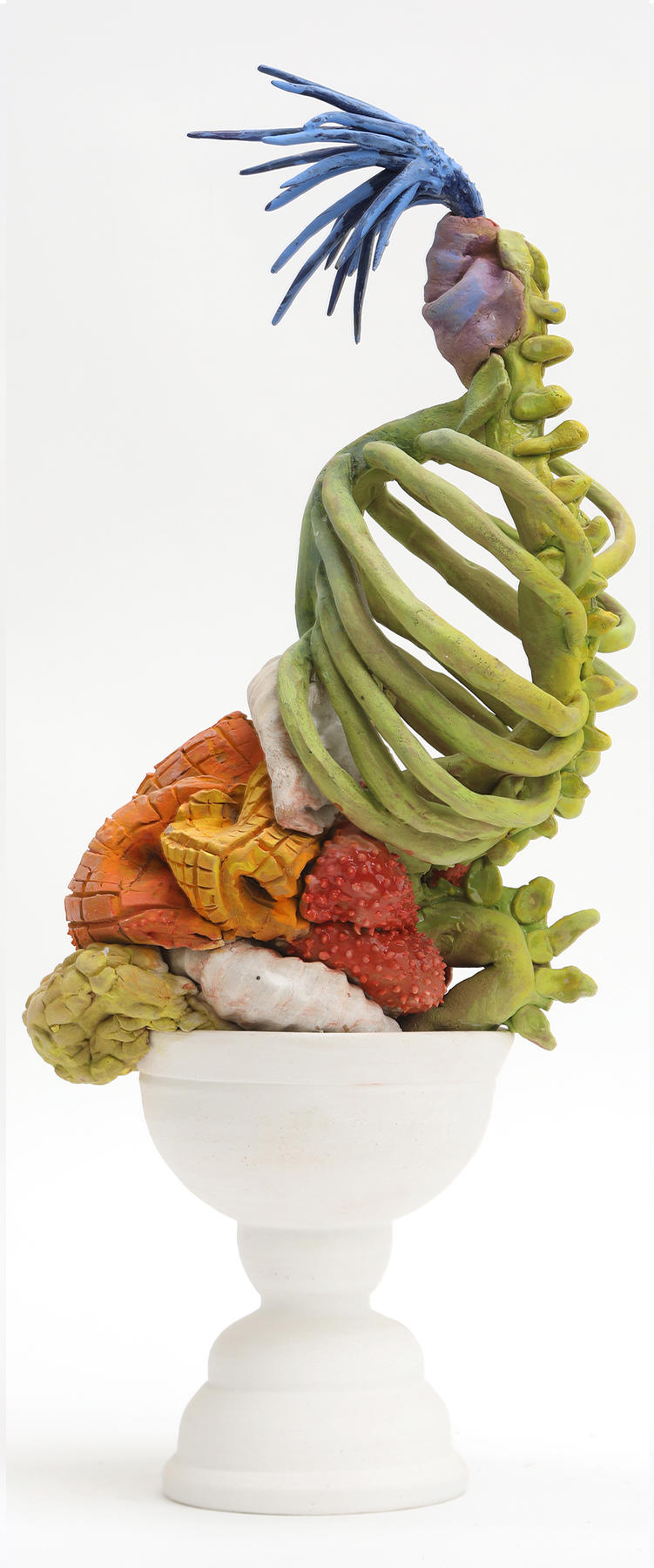
"Vanitas" (2020). Vessel is approx. 20"T x 6"W x 9"D.
Experimental piece involving the collision of thrown and sculpted elements.
Inhabiting Space
I often begin my process by constructing narrative and my goal is for the act of viewing to allow the work to unfold as it is viewed and the complexity of the designs processed.
The design of my work reflects the framework of stories: there are decisive beginnings and endings at the foot and lip or finial of a vessel, discrete characters, and conflicts within a single piece. Because I am creating both the narrative and the vessel that reflects it, the two processes can inform each other; I can capture a conflict, a tension, or a transformation that might not otherwise be apparent.
Furthermore, each of my pieces are constructed through a meeting of ceramic gestures. Marked and knotted clay, networks of coils, and richly glazed surfaces are considered discretely before they become merged. This parallels the creation of the chimaera where the creature is not only its own being but a meeting of snake, lion, and goat.
The chimaeric structure of the grotesque, the monstrous, and the abnormal allows for an indulgent and hedonistic space where conflicting visual languages create generative dialogues. To me the grotesque and the monstrous are examples of hedonistic structure and desire, existing as outliers due to their distance from an accepted norm.
Clay offers the capability for both complete control and complete surrender, but most of all it allows us to build new things. By creating work that is grotesque, monstrous, and unusual, but clearly constructed by an artist’s hand, I can suggest the possibility of constructing a world that is crafted to reflect what we want about ourselves.
The Metamorphic, The Grotesque, & The Hybrid
The metamorphic and chimaeric are examples of The Grotesque.
Metamorphism is drawn from Ovid and features a process of transformation between one form and another. The chimaera is a hybrid creature that often embodies a conflict or paradox. The grotesque are creatures that feature these processes in a constant state of unfolding.
Image
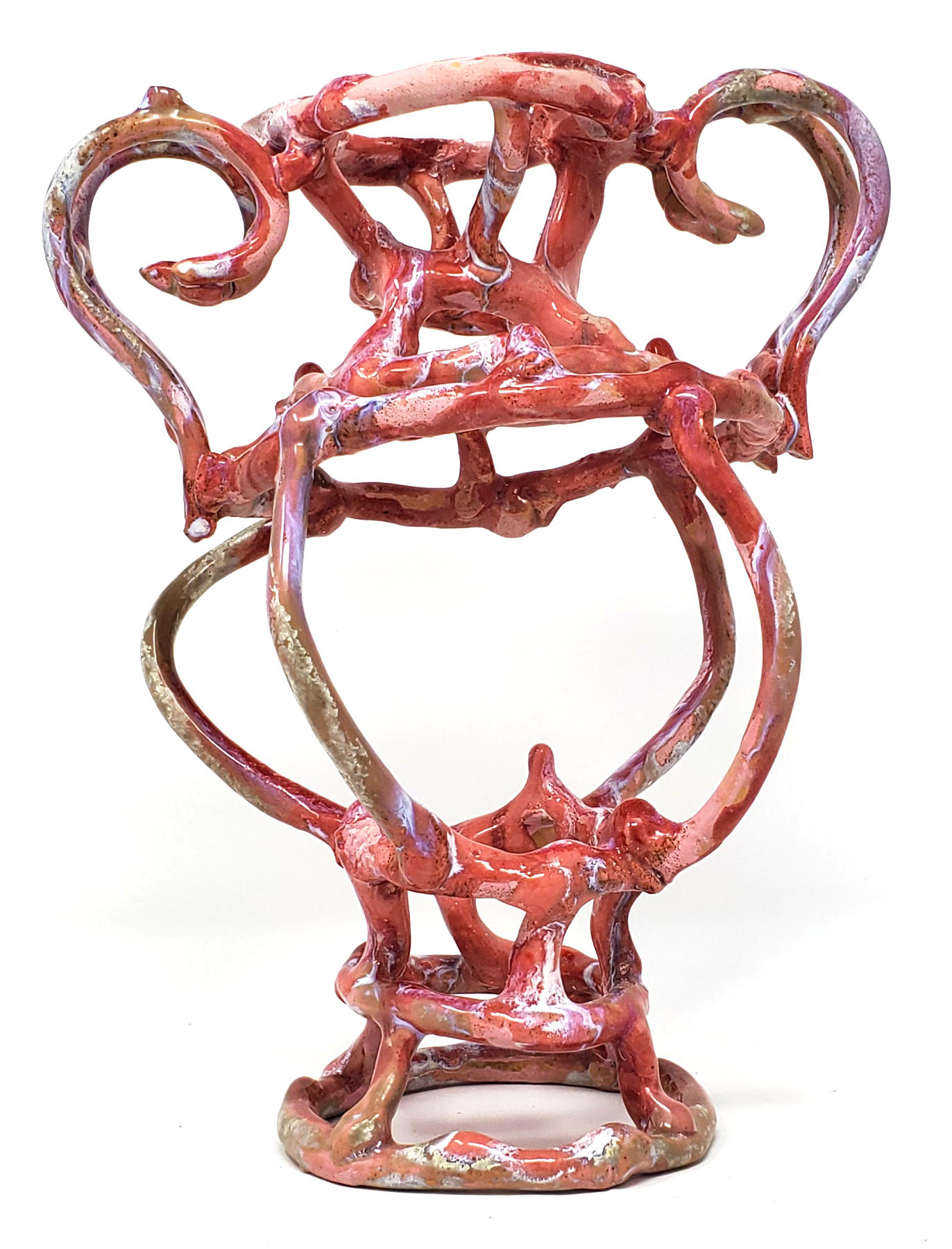
"#Mood" (2020). Sculpture approx. 11"T x 6"W x 4"D.
Exploration of the simplification of form and "the deficient."
The Grotesque
The Grotesque originated in the paintings and sculpture of ancient Rome. During the Renaissance in the sixteenth century the style was rediscovered on the walls of Nero’s palace after a thousand years of being buried beneath the earth. The imagery was, at the time, an avant garde collision of plant, animal, design and the unknown, their fusion made possible through their situation on the pictorial plane or through their embodiment in sculpted material. The otherworld of the canvas. When faced with an artistic challenge to inhabit space, the artisans became curators of a blank world where anything could happen. They were able to violate norms and question categories while subverting and destabilize the rules; mixing, matching, and pruning. Here we see the chimaera and the metamorphic; the collision and change of fragments of the known into the fantastic and mythic.
Image
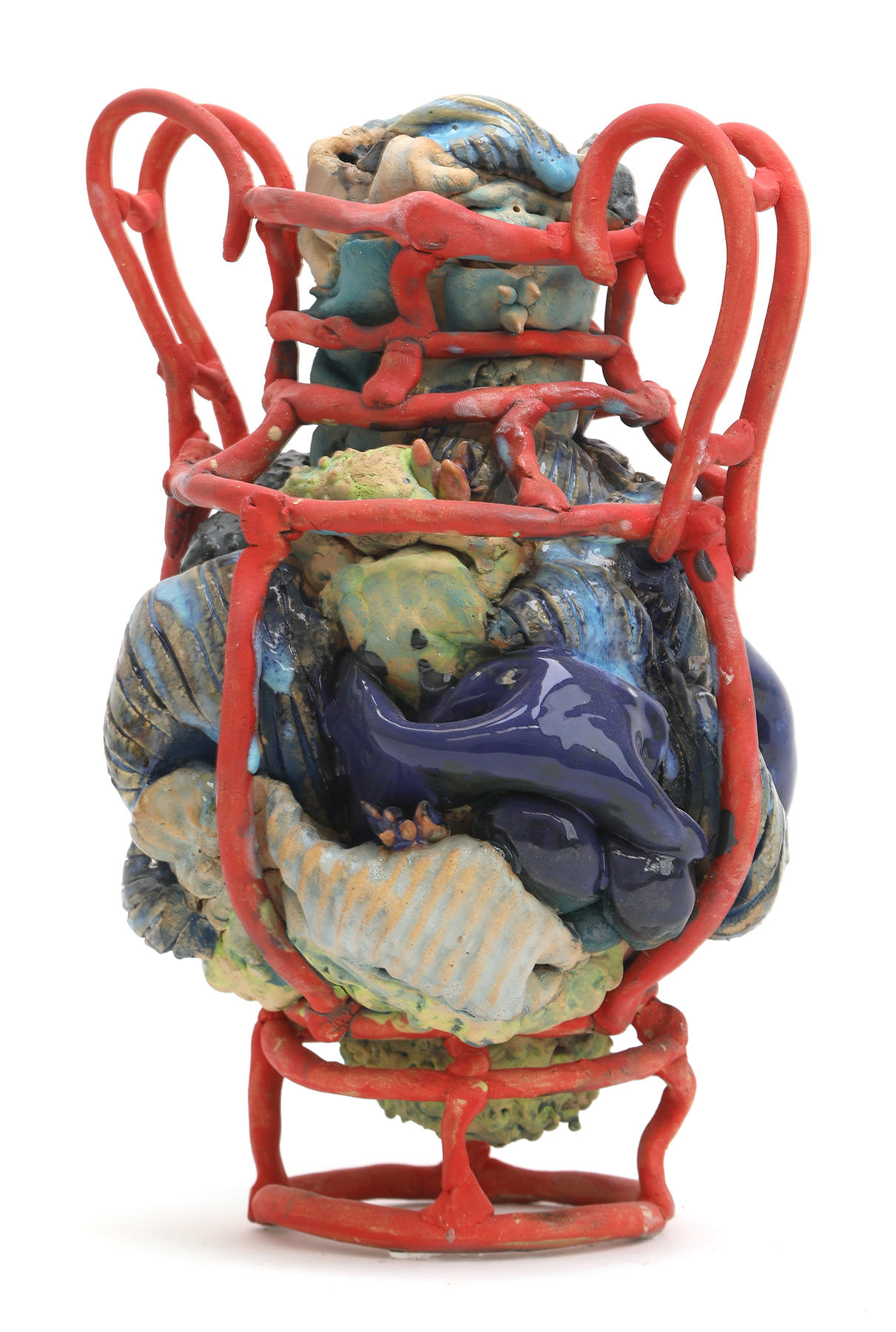
"#Inheritance" (2020). Sculpture approx. 12"T x 7"W x 5"D. Exploration of the collision of forms and "the hybrid."
Burial and Separation
What draws me to the grotesque is how literally it embodies this descent into another world. By falling through the earth we are engulfed in an even more fertile reality that can house boundary creatures whose alterity is considered monstrous above the ground. A chthonic world where monsters are the norm, and the normal becomes the abnormal.
In Monster in the Garden by Luke Morgan (an important book in the development of my thinking around my thesis) Morgan offers a categorical system for the grotesque: the excessive, the deficient, and the hybrid. Each stems from a literary history that examines how the grotesque are defined in relation to “the norm,” either by how many body parts they possess or how they are mixed with the features of animals.
The grotesque reject the ideologically “perfect” body plan, and these alternate, possible configurations are not only rare-- but monstrous. Their very existence classes them as unsettling because they do not conform to the normative and their unalterable body makes them incapable of doing so.
Image
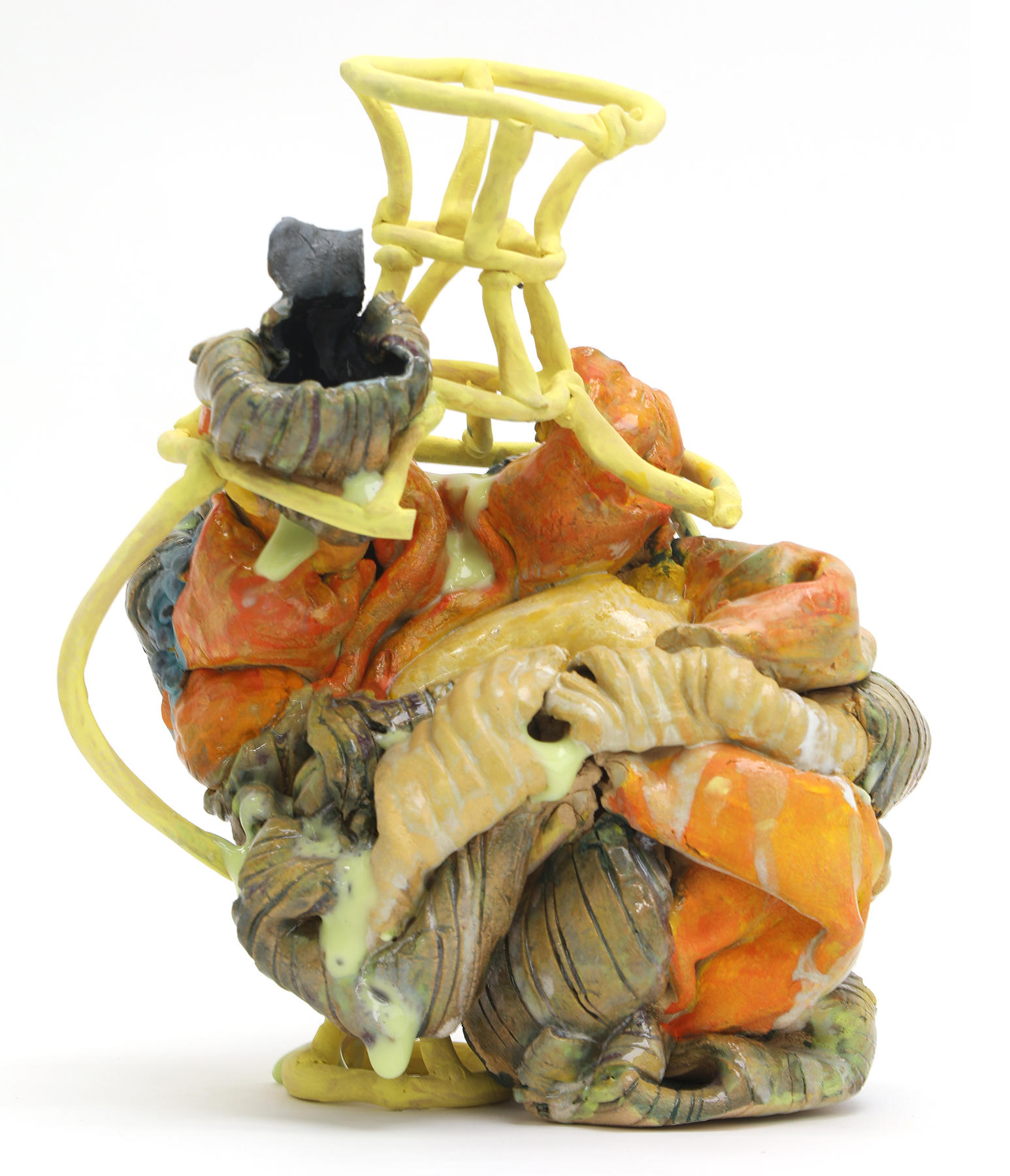
"Yearn" (2020). 10"T x 10"W x 8"D.
Exploration of the collision of form and "the excessive."
Some Experimental Works from Along the Way
Work pictured in slideshow (In Order):
"Succumb" (2020). Approx. 24”T x 5”W x 5”D. "Sight Seeing" (2020). 16"T x 7"W x 7"D.
"Ponder" (2020). Approx. 28"T x 8"W x 8"D. "Circus" (2020). Approx. 26"T x 12" W x 12"D.
"Testing Ground" (2020). Approx. 14"T x 48"W x 3.5"D. (Each block is 3.5" cubed and separates).
Indulgent Wonder
I hope that the viewer leaves my work with a sense of wonder and a sense of the possible. Todays society is intent on boxing, branding, and framing people and experiences in a way that is productive for the algorithms and reductive for empathetic human interaction.
My hope is that people turn back to the world and look at it for what it is rather than how it’s been packaged. That most things are chimaeric in nature, being composed of many analogous and conflicting systems and experiences. That people and things are always in a state of flux and metamorphosis. That monstrosity and hedonism are a matter of framing, and they tell us more about the norm than they do about their subject.
And most of all, that sometimes (at any age) it’s okay to escape into another world, especially if it’s just to see what’s there.
Who is Matt Becker?
Matt Becker is a multi disciplinary artist who works across the fields of ceramics, illustration (digital & traditional), painting, and writing. He has used his time at RISD to explore the ceramic medium in greater depth and find how he could best leverage it towards his ultimate goal of telling more inclusive, original, and robust stories. While he was at RISD he completed a short graphic novel, learned how to 3d model, survived a pandemic, finished a Collegiate Teaching Certificate program, taught one in person class, one Zoom class, and bought way more bubble tea than any one person should be allowed to.
Moving forward Matt plans to create a range of works that speak to his interest in stories/hedonism/the grotesque that span from lavish and beguiling to intimate and accessible.

